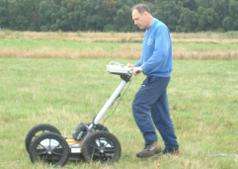Geophysics used to locate WW2 spitfire

On the 75th anniversary of the Battle of Britain, Peter Masters, a Research Fellow from Cranfield University's Forensic Institute, commences a new geophysical survey this week searching for a Spitfire which crashed in World War II.
The Spitfire X4593, which crashed on 22 November 1940, was based at RAF Wittering. It crashed in the Great Fen project area, in Cambridgeshire with the pilot unfortunately killed in the accident.
This survey follows initial metal detector examinations, within the identified field, which located aluminium fragments of the plane. Cranfield will be working with Oxford Archaeology East, who will manage the excavation in October; with the teams assisted by the Great Fen Archaeology group and other local amateur archaeologists.
Using a magnetometer, to measure small magnetic changes in the soil, Mr Masters will pinpoint the exact location of the aircraft wreck within in the field, mapping out the excavation area. The disturbed soils provide a contrasting magnetic signal with anything in the ground such as disturbed soil, walls or metal providing a reading. Data are collected and using computer software which generates a graphic of the surveyed area.
Ground penetrating radar will also be used during the survey as the finds could be up to four metres down lodged in the harder clay beneath the soft peat topsoil.
Mr Masters said: "We are always considerate of the fact that someone lost their life in any site like this. The Protection of Military Remains Act protects them and it is important that the site is considered properly.
"I have worked on several aircraft sites in the past including the Salisbury Plain Spitfire excavation in 2013. We anticipate that, because this plane crashed into peat, the engine and other parts of the plane are likely to be quite well-preserved."
Material from the excavation site will be taken from the site for sorting and cleaning with all artefacts remaining the property of the Ministry of Defence. It is expected RAF Wyton Pathfinder Museum will be asked to receive any material for conservation.
It has been estimated that around 10,000 military aircraft were lost over the United Kingdom during the 20th Century, of these, only about one fifth are recorded on heritage databases. Although various wartime records of these losses do survive their precise location was often poorly recorded or is not now obvious.
Provided by Cranfield University





















